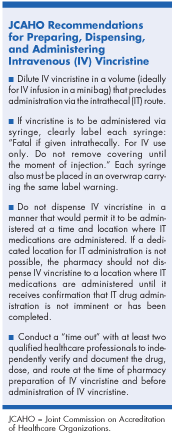How to Prevent Inadvertent IT Administration of Vincristine
In July 2005, the Joint Commission on Accreditation of Healthcare Organizations (JCAHO) issued a sentinel event alert on the prevention of inadvertent intrathecal (IT) administration of vincristine.
BOSTONIn July 2005, the Joint Commission on Accreditation of Healthcare Organizations (JCAHO) issued a sentinel event alert on the prevention of inadvertent intrathecal (IT) administration of vincristine. At the 31st Annual Congress of the Oncology Nursing Society (abstract 22), Maria (Monny) Slezak, RN, BSN, OSN, discussed how her institution responded to the alert to help "preserve the center's zero-error rate." Ms. Slezak is clinical director of oncology services at the University of California, San Diego (UCSD) Medical Center-Moores UCSD Cancer Center.
Ms. Slezak called IT administration of vincristine, "a potentially fatal yet very preventable error." Cases are rare but usually have tragic results. In the United States, she said, three databases have reported 12 cases: Three of these errors were caught before reaching the patient, two patients had permanent paralysis as a result of IT vincristine administration, and there were five deaths, one unspecified injury, and one unknown result.
Authorities in the United Kingdom have reported 14 cases of IT vincristine administration since 1975.
"Despite specific requirements for labeling and a rigid dispensing standard imposed by the United States Pharmacopeia (USP), these errors continue to occur," Ms. Slezak said.
Recommendations
In response to the JCAHO alert, UCSD added the JCAHO recommendations for preventing vincristine administration errors (see Table) to the center's own policy on handling and administering antineoplastic drugs, and also implemented other safeguards.

At UCSD, Ms. Slezak said, "vincristine will always be dispensed by pharmacy diluted in a minibag; it will no longer be dispensed in 3 mL syringes. Vincristine should be administered over 5 to 10 minutes. If it is to be administered via peripheral access, the nurse should stay at the bedside to check blood return for potential extravasation during the 5- to 10-minute infusion period."
She emphasized that the pharmacy will not dispense IV vincristine to a location where a patient is to ultimately receive IT medication until it receives confirmation that IT drug administration is not imminent or has been completed.
Special Handling of IT Drugs
The UCSD Patient Safety Committee also made changes in the labeling and packaging of IT drugs and documentation of their use, based on the JCAHO recommendations for IT drugs. [The JCAHO recommendations can be found online at www.jointcommission.org/SentinelEvents/SentinelEventAlert. Click on Issue 34.]
Ms. Slezak said that all IT drugs administered at UCSD must be provided in a LuerLok syringe; must be packaged in a separate, fluorescent, slide-closure bag labeled for IT administration only; and must be delivered separately from other chemotherapy agents.
To address problems of verifying IT drug orders, she said, the UCSD team developed a multidisciplinary check-off document that accompanies the IT medication from the pharmacy, to the nursing unit, to the patient's bedside, and becomes part of the patient's permanent medical record. IT administration is performed only by specially trained practitioners, she added, and this is documented on the check-off sheet.
Other JCAHO recommendations regarding IT drug administration include:
• Preparing IT drugs in the pharmacy as near as possible to the time of administration, labeling them with an appropriate short expiration time (eg, 8 hours), and delivering them to and adminstering them in a designated (ideally separate) location, at a regular, specified time of the day or week.
• Establishing a list of drugs that can be given intrathecally, designating specific locations where IT administration may be done, and banning all other injectable drugs from those locations during times when IT drugs are injected.
• Conducting a "time out" with at least two qualified healthcare professionals to independently verify and document the drug, dose, and route at the time of pharmacy preparation of drugs for IT administration and before each IT administration of such drugs.